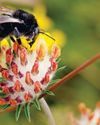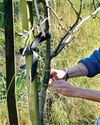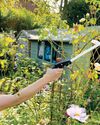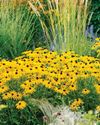
FRITILLARIES are a varied and beautiful group of plants from a wide range of geographical locations, from water meadows and woodlands to mountains and semideserts. Their name derives from the Latin fritillus, meaning dice box or chess board, and is probably a reference to the chequered markings of the snake'shead fritillary (Fritillaria meleagris).
Members of the lily family, fritillaries survive drought or cold by dying back to underground bulbs. Now in the autumn is the time for planting these, so their roots can grow out into warm, moist soil, laying a good foundation for spring growth and flowers. Fritillarias can be fussy about soil and location, and need thoughtful siting, or grow them in pots using compost tailored to suit.
Nodding orange bells
My first encounter with fritillary bulbs was in the 1970s when my 'Saturday job' was working in a pet and garden shop. Flat display boxes would arrive in the autumn, their lids opening to reveal compartments of bulbs with pictures above. One held the large, foxy-smelling bulbs of crown imperial (F. imperialis), and unable to resist the prospect of nodding orange bells under a crown of bracts, I carried home bulbs in lieu of wages. Planted on their sides (to aid drainage) in a deep hole made in our stony, well-drained soil, they went on to flower every spring for many years.
Grass, rock gardens and borders
Bu hikaye Amateur Gardening dergisinin October 15, 2022 sayısından alınmıştır.
Start your 7-day Magzter GOLD free trial to access thousands of curated premium stories, and 9,000+ magazines and newspapers.
Already a subscriber ? Giriş Yap
Bu hikaye Amateur Gardening dergisinin October 15, 2022 sayısından alınmıştır.
Start your 7-day Magzter GOLD free trial to access thousands of curated premium stories, and 9,000+ magazines and newspapers.
Already a subscriber? Giriş Yap

To dig or not to dig?
Should we be carrying out a full dig on plots now? Bob considers the pros and cons of the 'autumn dig' debate

The box ball blues
As if his beleaguered box hadn't already taken a beating, Toby now has to deal with some hungry box caterpillars

Save your own seeds
Masterclass on: seed saving

Strange sightings
Three unusual insects turn up in Val's garden in one day

A bolt from the blue!
Cornflowers are perfect for garden and vase

Winter moth prevention
Ruth shows you how to avoid maggoty tree fruits

Create a winter container
There are as many options as in summer

Lightweight gardening tools
AS well as being good for our mental health, gardening is also great exercise.

Autumn price round-up
AG finds better bargains in lesser-known brands

Rudbeckias
Rudbeckias are ideal for sunny summer patios and borders, with some able to survive our coldest winters